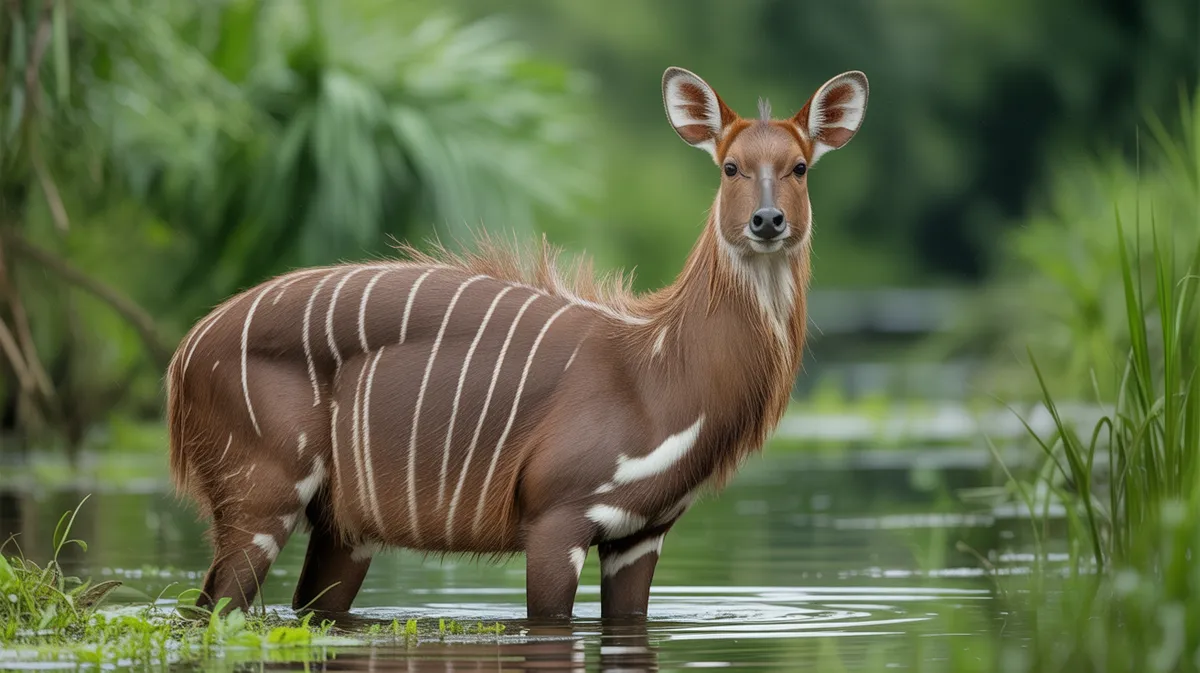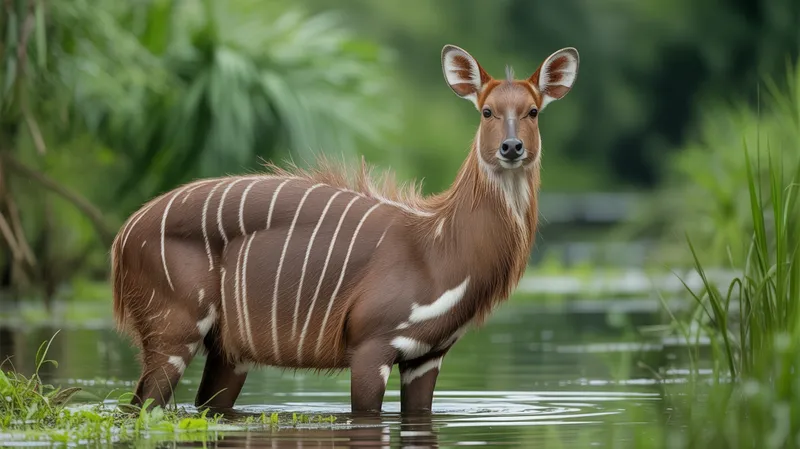
Sitatunga
Tragelaphus spekii

Meet the Sitatunga
The sitatunga is a medium-sized, semi-aquatic antelope native to central Africa's swamps and marshes. Its shaggy, water-repellent coat and long, splayed hooves make it perfectly adapted to life in wetlands, allowing it to move easily through muddy, reed-filled environments. Males boast spiral horns and are darker in coloration, while females are smaller and reddish-brown. Sitatungas are shy and elusive, relying on dense vegetation for cover and are rarely seen far from water. Their unique adaptations and secretive nature make them one of the most specialized antelopes in Africa.
Classification
Mammal
Habitat
Swamps, marshes, wetlands, and dense riverine vegetation
Diet
Herbivore
Lifespan
12-20 years
Conservation
Least Concern
Weight
50-120 kg
📖Fascinating Facts
Wetland Specialist
The sitatunga is one of the few antelopes adapted exclusively to swampy environments, where it spends most of its life.
Superb Swimmer
Sitatungas are powerful swimmers and will often escape danger by plunging into the water, sometimes staying submerged with only their nostrils exposed.
Keen Senses
These antelopes rely heavily on their sense of smell and hearing to detect predators lurking in dense vegetation.
📋Detailed Description
The sitatunga (Tragelaphus spekii) is a highly specialized, semi-aquatic antelope with a distinctive shaggy, oily coat that repels water and provides insulation in its wetland habitat. Adult males typically stand 81–116 cm (32–46 in) at the shoulder and weigh between 76–119 kg (168–262 lbs), while females are smaller, standing 72–90 cm (28–35 in) and weighing 24–57 kg (53–126 lbs). Males are characterized by long, spiral horns (up to 92 cm/36 in), a darker brown to grayish coloration, and a pronounced mane and white facial markings. Females lack horns and are more reddish-brown with prominent white stripes and spots along the flanks. Both sexes have elongated, splayed hooves with flexible joints, enabling them to walk on soft, unstable substrates and even swim with ease. Their large, mobile ears provide acute hearing, aiding in predator detection. Sitatungas are primarily crepuscular, emerging at dawn and dusk to feed, and are known for their secretive, solitary or loosely social nature. They are excellent swimmers, often submerging themselves with only their nostrils and eyes above water to avoid predators. Their diet consists mainly of aquatic and semi-aquatic vegetation, including sedges, reeds, grasses, and occasionally browse. Sitatungas play a crucial ecological role in wetland environments by influencing plant community structure and serving as prey for large carnivores.
💡 Did you know?
Sitatungas can rotate their hooves sideways, a unique adaptation that helps them maneuver through thick reeds and deep mud.
🔬Research & Sources
Wikipedia Summary
The sitatunga or marshbuck is a swamp-dwelling medium-sized antelope found throughout central Africa, centering on the Democratic Republic of the Congo, the Republic of the Congo, Cameroon, parts of Southern Sudan, Equatorial Guinea, Burundi, Ghana, Botswana, Rwanda, Zambia, Gabon, the Central African Republic, Tanzania, Uganda and Kenya. The sitatunga is mostly confined to swampy and marshy habitats. Here they occur in tall and dense vegetation as well as seasonal swamps, marshy clearings in forests, riparian thickets and mangrove swamps.
Last Modified: 2/15/2025
🎭Behavior & Social Structure
Sitatungas exhibit a predominantly solitary lifestyle, although small groups of females and their young may be observed, especially in areas with abundant resources. Males are generally more solitary and territorial, with home ranges that may overlap those of several females. They are highly elusive, relying on dense vegetation for cover and rarely venturing far from water. Sitatungas are most active during the early morning and late afternoon, spending the hottest parts of the day resting in thick reeds or papyrus beds. Their feeding behavior is adapted to their marshy environment; they use their prehensile lips to selectively browse on tender shoots, leaves, and aquatic plants, often wading or even swimming to access food. When threatened, sitatungas may freeze, relying on their cryptic coloration, or slip silently into water, where they are adept at moving with minimal disturbance. Communication is primarily through scent marking and soft vocalizations, such as low barks or grunts, especially between mothers and calves.
👶Reproduction & Life Cycle
Sitatungas are polygynous, with dominant males mating with multiple females within their overlapping territories. Breeding can occur year-round, but peaks are often observed during the rainy season when food is most abundant. After a gestation period of approximately 240–250 days (about 8 months), females give birth to a single calf, which is carefully hidden in dense vegetation for several weeks. The mother visits the calf only to nurse, minimizing the risk of attracting predators. Calves are born with a spotted coat for camouflage and are able to stand and move within hours. Weaning occurs at 3–6 months, but young may remain with their mothers for up to a year. Sexual maturity is reached at 1–1.5 years for females and around 2 years for males, though males may not breed until they are older and able to compete for mates.
🛡️Adaptations & Survival
Sitatungas possess several remarkable adaptations for life in wetlands. Their elongated, splayed hooves distribute weight and prevent sinking into mud, while flexible pastern joints allow for silent, agile movement through thick vegetation and water. The oily, shaggy coat repels water and insulates against cold and dampness. Their cryptic coloration and vertical white stripes mimic the play of light in reeds, providing camouflage from predators. Sitatungas are strong swimmers, able to cross deep water and even submerge to evade danger. Their nostrils can close to prevent water ingress, and their large, sensitive ears enhance auditory detection in dense habitats. Behaviorally, their secretive nature and tendency to freeze or slip into water at the first sign of danger are key anti-predator strategies.
📚Research Sources
🎨Cultural Significance
The sitatunga holds varying degrees of cultural significance across its range. In some Central and East African communities, it is hunted for meat, hides, and horns, which may be used in traditional ceremonies or as trophies. Its elusive nature and association with wetlands have led to its appearance in local folklore, often symbolizing stealth, adaptability, or the spirit of the marsh. In certain regions, sitatunga horns are believed to possess protective or medicinal properties. Increasingly, the sitatunga is recognized as a flagship species for wetland conservation, helping to raise awareness about the importance of preserving these critical habitats.
🔬Recent Research & Discoveries
Recent research on sitatunga has focused on their habitat use, genetic diversity, and responses to wetland degradation. Studies using GPS telemetry have revealed fine-scale movement patterns and habitat preferences, highlighting the importance of undisturbed, contiguous wetlands for their survival. Genetic analyses indicate significant population structuring, suggesting limited dispersal between isolated wetlands and underscoring the need for habitat connectivity. Conservation research has also examined the impact of invasive plant species and human encroachment on sitatunga populations. Ongoing studies are investigating their role in wetland ecosystem functioning, including their influence on plant community dynamics and nutrient cycling. There is growing interest in the sitatunga as an indicator species for wetland health, given its sensitivity to habitat changes.
🎥Wildlife Videos

NEW! Sitatunga Private Island & Suite | Great Plains
We all at least know of the magic of Botswana's Okavango Delta, the real Okavango. That place so far into the waterways that it ...
Great Plains Conservation

NILE RIVER | Survival Tales in Africa's Lifeline #naturedocumentaries | Wild Nature
NILE RIVER | Survival Tales in Africa's Lifeline #naturedocumentaries | Wild Nature Welcome to the channel! Today, we're ...
WILD NATURE - Nature animal documentary

The Dark Jungle - Wildlife documentary | Jungle Planet series | Nature Animal Documentary
African rainforests are the oldest in the world. They are inhabited by gorillas, chimpanzees and okapi. The biodiversity of these ...
EARTH PLANET

Wildlife - The Fascinating World of Wild Animals | Full Series | Free Documentary Nature
Wildlife - The Fascinating World of Wild Animals | Wildlife Documentary Watch 'Ocean Stories - Full Series' here: ...
Free Documentary - Nature

The Incredible Wildlife Living At Our Equator | Equator Specials
The sun shines most powerfully at the Equator, here it is able to power extraordinary life. From the large trees covering the ...
All Out Wildlife

Giving Nature a Voice: Saving Sitatunga
It's one of the rarest antelopes in Kenya, uniquely adapted to its watery home. Splayed hoofs and a slick coat allow the Sitatunga ...
The Ismaili TV
🌍Habitat Information
The Sitatunga typically inhabits Swamps, marshes, wetlands, and dense riverine vegetation environments. Sitatungas have adapted to their environments with specialized features and behaviors.
Primary Habitat:
Swamps, marshes, wetlands, and dense riverine vegetation
More detailed habitat information will be available soon.
🛡️Conservation Status
The Sitatunga is currently classified as Least Concern. Conservation efforts are crucial for preserving this species for future generations.
Common Threats:
- 🏠Habitat loss and fragmentation
- 🌡️Climate change impacts
- 🎯Hunting and poaching
- 🏭Human-wildlife conflict
⚠️Threats & Conservation Challenges
While the sitatunga is currently listed as Least Concern by the IUCN, it faces significant localized threats. Wetland drainage, conversion to agriculture, and habitat fragmentation are major concerns, especially as wetlands are among the most threatened ecosystems globally. Overhunting for meat and traditional medicine, as well as incidental snaring, also impact some populations. Invasive plant species and competition with livestock can degrade habitat quality. Climate change poses a long-term threat by altering hydrological regimes. Despite these challenges, sitatungas remain relatively widespread, but populations are declining in some regions, particularly where wetland protection is inadequate.
🔬Scientific Classification
Scientific Name
Tragelaphus spekii
Classification Hierarchy
🔍 About Taxonomic Classification
Taxonomic classification is a hierarchical system used by scientists to classify and organize living organisms based on shared characteristics and evolutionary relationships.
The system moves from broad categories (Kingdom) to increasingly specific ones, with each animal's scientific name typically consisting of its Genus and species.
📝Community Notes
Share your observations and insights about the Sitatunga with our community of wildlife enthusiasts.
Join Our Community
Sign in to share your observations and connect with fellow wildlife enthusiasts.
Sign In to ContributeNo community notes yet
Be the first to share your observations about the Sitatunga!
Explore Sitatunga
Select a tab above to learn more about this amazing animal.
📸Photo Gallery
No photos available for this animal yet.
🌟Discover More Wildlife
Continue your journey of discovery with more fascinating animals from our database
